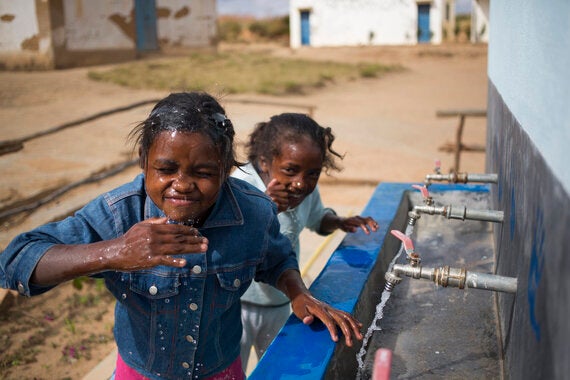
Fanja, eight years old, (in blue) washes her face at the handwashing station at St Paul Primary School in Fenoarivo village, Ankazobe district, Madagascar. Nearly half the children in Madagascar suffer from stunting and the country's access to water and sanitation is still extremely low. Photo credit: WaterAid/ Ernest Randriarimalala
If malnutrition is the 'new normal,' as stated by this week's 2016 Global Nutrition Report, then the scale of the challenge we all face to fulfil the new Global Goals to end poverty and address inequality by 2030 has just become even more stark.
One in three people globally are affected by malnutrition -- whether through undernutrition which stunts growth and development, or what is termed in the health community as overnutrition, displayed in obesity and growing rates of diabetes and other illnesses. This is a global crisis, affecting nearly every country in the world.
Within these findings is the staggering revelation that currently 159 million children in our world are stunted - millions of lives who will never reach full potential, depriving the world of future great leaders, entrepreneurs, thinkers, inventors and athletes because their bodies have been starved of the nutrients needed to help them develop.
Unacceptably high costs
This number is unacceptable. And the knock-on costs are incredibly high, not just in lost potential. An estimated 11 per cent of GDP is lost every year in Africa and Asia from malnutrition, from low weight, poor child growth and micronutrient deficiencies. The economic impact alone globally each year is greater than what was lost during the 2008 financial crisis.
Addressing malnutrition will require a coordinated approach, starting with that basic building block of development: clean water and good sanitation.
The World Health Organisation has estimated that half of all undernutrition is associated with infections caused by drinking dirty water contaminated with faeces, and eating food with unclean hands. With 650 million people worldwide without access to clean water, and 2.3 billion - or one in three people around the world - without access to a proper toilet, it can be no surprise that deadly disease and infection follow.
Some 315,000 children die each year from diarrhoeal illnesses linked to dirty water, poor sanitation and poor hygiene. What this report tells us is that those who survive are often not unscathed.
Considering the whole picture
A child who is suffering from chronic diarrhoeal illness or intestinal worms is simply no longer able to absorb nutrients, no matter how high-quality the nutrition available is, and one-quarter of all stunting can be linked to as few as five episodes of severe diarrhoea before age 2.
Among the Global Nutrition Report's findings are that 'nutrition-specific' interventions such as micronutrient supplementation and fortification, even at 90% coverage rates in the hardest-hit countries, are thought to address only 20% of the global stunting burden.
It should be incredibly obvious. How can children avoid malnutrition when their young stomachs are full of intestinal worms from dirty water? How do we expect nutritional supplements to do the job on their own?
When we look at addressing malnutrition, we need to look at the entire picture.
It is clear that crises do not respect tidy sectoral boundaries or ministries. WaterAid's Healthy Start advocacy work pushes to integrate water, sanitation and hygiene as part of global and national action plans for nutrition and health; we work with healthcare professionals on a more holistic approach.
Turning buzzwords into action
Our pilot programme in Nepal has trained community health outreach workers to teach parents about the importance of good hygiene during regular immunisation clinics, an approach which we believe will help reduce levels of childhood diarrhoea and improve growth and development.
For all those in development, integration needs to be turned from buzzword into action, through specific, measurable, attainable, relevant and time-bound investments that deliver lasting change for communities living in poverty.
Those of us working to help improve access to water, sanitation and hygiene need to consider how to maximise our impact on nutrition, better health and livelihoods. And no nutrition programme should ignore the critical importance of clean water, good sanitation and good hygiene practice in child health to minimise diarrhoea and to allow their small bodies' to absorb nutrients.
A key message of the Global Nutrition Report is that ending malnutrition is a political choice that is achievable, but only with an increase in effective funding and infrastructure and much more efficient coordination across relevant sectors. This is true for malnutrition, for access to water, sanitation and hygiene, and for eradicating extreme poverty.
Achieving water, sanitation and hygiene for all is not one, isolated goal. It is the key to transforming lives.
